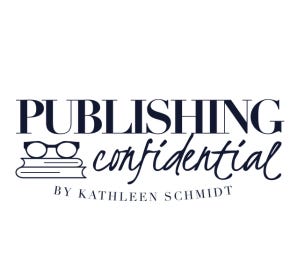Bestseller Lists are Broken
Bestseller lists are disappearing and the ones that still exist aren't equitable. It's a problem.
You are receiving a rare Sunday newsletter from me because it is my final free day before my next MBA class begins tomorrow: Strategic Opportunity Management. It is the last of my required classes! After that, I am taking a brand management class. In the meantime, I have begun applying to doctoral programs. Yes, I will insist that you call me Dr. Schmidt someday.
I can hardly believe that publishing confidential is inching towards 5K subscribers. Thank you to everyone who has subscribed and shared posts. Here is the subscription housekeeping:
Today, we are going to discuss bestseller lists. A lot has been written about the ambiguity of The New York Times bestseller list. Esquire magazine published a piece last year covering many of the problems on the NYT list. I was quoted in the piece and stand by what I said, but I also want to write about what wasn’t.
I. The New York Times bestseller list needs to be transparent.
The New York Times isn’t transparent about how they compile data for their bestseller list. However, having worked on books that outsold others with higher rankings on the list, I figured out a few things. Mainly, the Times places some books on the list with a ranking they feel like assigning to it. I have seen this time and again with both fiction and nonfiction. When I was V.P. of Publicity at Atria, a particular fiction author was obsessed with their ranking on the NYT list, so I was charged with obtaining sales figures from Bookscan for every book ranked versus theirs. It was my first exposure to the racket that is the NYT list. Yes, I said racket. According to the data I pulled, the author’s book should have been in the top ten, not the bottom five. I called the person who compiled the list and argued my point. The response I received was, “We can’t disclose how we compile the list.” That was 2006. Nothing has changed.
The lack of transparency from the NYT about its bestseller list is problematic for several reasons:
Book publishers include “bestseller clauses” in some contracts where an author receives a monetary bonus if their book gets on the NYT list. If the NYT isn’t transparent about its methodology, publishers shouldn’t give financial bonuses when an author’s book is on it. This is incredibly inequitable for marginalized authors who historically receive lower book advances. What if the NYT places a white author’s book on the list when a non-white author’s book should be there? Conversely, what if a nonfiction book’s subject matter is disagreeable to the NYT, and they purposely omit it from the list? Unless publishers know what data is being used to compile the NYT list, there will always be a chance that some authors will receive monetary bonuses they didn’t earn. This is not a slight towards authors. Instead, it is the first step in creating a better system for bestsellerdom.
There is favorable retail marketing for NYT bestselling books. Walk into Barnes & Noble, and you will see NYT bestselling books front and center. Why? Because it’s a good marketing ploy. Consumers are programmed to register “bestselling” as “popular” and therefore “in demand.” The authors, stores, and publishers benefit from this. If something is “in demand,” one assumes it will become scarce. Scarcity is the driver behind many retail purchases. For example, when you shop on a clothing brand’s website, you’ll often see “Selling fast!,” “Bestseller,” or “Only a few left!” next to the shirt you’re considering. You are more likely to purchase it if you think it will sell out. The same philosophy applies to books. Do we know if there are only three shirts left? We do not, but we will probably buy it anyway because of scarcity!
Using “A New York Times Bestseller” tagline on a book cover is more meaningful than blurbs. Again, this is because when the average consumer knows everyone loves a book, they think they should buy it. This, of course, doesn’t apply to every consumer, but it applies to most.
There is a certain cache in saying you are a NYT bestselling author. This doesn’t need an explanation because we know it is true.
The longer a book remains on the list, the more free marketing it receives. People who still read the print edition of The New York Times Sunday Book Review will see the book’s title printed on the bestseller list for as long as it remains there. You can’t buy that kind of marketing, except you can.
People game the NYT list. Some companies charge thousands of dollars to buy copies of a book in bulk to dump them in a warehouse to make the author a bestseller. There are also guerilla marketing firms who will activate “street teams” to buy several copies of a book from different indie bookstores that report sales to the NYT. Some politicians ask PACs, Super PACs, and other organizations to purchase large quantities of a book to save them from the embarrassment of not hitting the list. The commonality here is money. If someone can afford to game the list and has an ego that requires them to become a bestselling author, they will do so.
NYT bestselling authors receive more significant advances. Not only do they receive more considerable advances, but they also have the upper hand with agents and publishers. Who is going to turn down those authors? Not many people. The caveat is that you can’t expect to be treated as a contemporary bestselling author if your book hit the list in 2010 and you haven’t written anything since then. It depends on how many copies the first book sold, but the world has changed, and sales in 2010 aren’t comparable to 2023.
Publishers designate books as bestsellers. Last week, I wrote “The Anatomy of a Bestseller” for paid subscribers, which explains how publishers create campaigns for books that must become NYT bestsellers. You can read it here (but you must be a paid subscriber):
The Anatomy of a Bestseller
Hello Confidantes, Today’s newsletter is a deep dive into what goes into making a book a bestseller. But first, subscription housekeeping. Remember, I am running a special on paid subscriptions until 11/29! And, some exciting news! My website is live. It lists my services, how to contact me, and my bio + clients. Take a look at
II. The problem with disappearing bestseller lists.
The Wall Street Journal recently announced it is doing away with its bestseller list. This is concerning because:
The Wall Street Journal used data from Bookscan to rank books, making it one of the most accurate consumer-facing lists.
They included self-published authors on their bestseller lists. The New York Times bestseller list doesn’t acknowledge self-published authors. It is a shame because genre authors who self-publish (especially in the romance and thriller categories) deserve a chance at being national bestselling authors and the perks that come with it.
It was a dependable list for business books.
It was helpful to compare the WSJ list to the NYT list because books on the former would sometimes be absent from the latter.
Marketing!
USA Today discontinued its bestseller list, then reinstated it, and it is not as good as it used to be:
Book publishing was rightfully upset when USA Today tried to discontinue its bestseller list last December. It was reinstated after a few months but is not quite the same because it is more automated.
USA Today has removed all bestseller lists before 2023 from its websites.
It has 150 spots. The paper says it “collects sales data from booksellers representing a variety of outlets: bookstore chains, independent bookstores, mass merchandisers, and online retailers. Using that data, we determine the 150 top-selling titles of the week.” Guess what that means? Self-published authors are few to none on the list. It wasn’t always this way. Self-published romance authors were mainstays on the USA Today list until this year.
USA Today combines sales data for electronic and printed books and uses the data to determine rankings. Again, this is a disadvantage to self-published authors whose primary (and only) format is an ebook.
Self-published authors have lost a substantial marketing tool in how USA Today compiles data.
Traditionally, published authors are faced with a more competitive bestseller list. 150 spots! All genres! Yikes. But:
You’ll sometimes find books on the USA Today list that are absent from the NYT list. It keeps things interesting.
How books are marketed matters as much for USA Today’s list as the NYT list.
III. Lists I am not focused on in this newsletter and why.
If the past nine months of writing this newsletter have taught me anything, someone will tell me what I didn’t write about. Let’s nip that in the bud: I’ve purposely not written about Amazon and B&N’s bestseller rankings because they are specific to each online retailer’s algorithms. I have omitted information about regional bestsellers because those lists often mirror the big ones. I didn’t write about Publisher Weekly’s bestseller list because it is not consumer-facing (though it is beneficial because it includes sales figures). I focused on NYT, WSJ, and USA Today because those are the bestseller lists publishers use to make certain decisions. They are also the most recognizable to consumers, affecting book sales.
IV. Solutions (kind of).
I like solving problems, so here is my stab at what should happen to bestseller lists:
A partnership with TikTok to print a list of the week's top trending books on BookTok. This would give authors, agents, editors, and publishers a realistic window into what works on TikTok. Billboard has a partnership with them to print a list of the top trending songs. I don’t understand why this hasn’t happened in book publishing. If USA Today did it, they’d attract a younger audience. Why wouldn’t you want that?
A partnership with Instagram to print a list of the week’s top trending books from Bookstagram. The audience is a different demographic than TikTok (older, usually).
Publishers collectively demand transparency from the NYT about how they collect data for their bestseller list. One can dream.
Structure bestseller bonuses differently in author contracts. See my first three points. If some media companies reward journalists for clicks and the number of social media followers they have (not sure this is still done, but some media used to do it), why not allocate financial bonuses for authors whose books go viral on TikTok? A video receives 1M views? The author should receive a bonus—something like that.
Jane Friedman is doing a public service by including a bestseller list in her newsletter, The Hot Sheet. It may not earn authors a bonus, but it will inform the industry about what is selling in the traditional indie and self-published world. AMENDED: There is no cost involved. You can find The Hot Sheet’s bestseller list here.
Place less emphasis on books becoming bestsellers and more on selling well over time. This would help authors’ headspace tremendously.
Create bestseller lists for marginalized authors. Essence’s bestseller list was wonderful back in the day because they had a fantastic book editor. It isn’t a secret that publishers will say books by marginalized authors don’t sell well. That is an old trope that has to die. When I was the late Eric Jerome Dickey’s publicist for eight years, I only heard how black books don’t sell. I made certain his books eventually hit the NYT list. His book signings were jam-packed. I went through the same thing when I worked with Zane: “Street lit doesn’t sell.” Yes, it does. The problem isn’t the books or authors. The problem is publishing.
Publishers Weekly should do a better job marketing their bestseller list to consumers.
Regional bestseller lists should be aggregated so more consumers see them. If I travel to Denver, maybe I want to know what’s selling well there!
Bring back international bestseller lists. We don’t need every country, but I love seeing what’s selling in the UK, France, Italy, Australia, etc. The publishing sensibilities outside the U.S. are different, and researching the cause and effect of books in foreign territories would help the industry here.
As always, questions/comments: publishingconfidential@gmail.com
Business inquiries ONLY: kathleen@kmspr.com
Please give me time to respond to your emails. I am getting there!
Programming note: Gift guides are coming this and next week!
Next up for paid subscribers: Train Your Brain Like a Book Publicist.
There are no end notes this week because it’s been hectic. I want to introduce you to a new family member: Ruger Miguel Schmidt. He is a 7.5-month-old Boston Terrier and the sibling to Cookie Dough Schmidt (she is the brown and white one)
:







Thanks for writing about this important issue, Kathleen.
I just wanted to let everyone know the Hot Sheet bestseller lists are free to everyone, no cost involved to view them. :)
Here's October 2023:
https://hotsheetpub.com/2023/11/october-2023-bestseller-lists/
November 2023 will be released on Wednesday at noon Eastern.
There is writing and then there’s the business of writing. And from what you are describing much of it is not on the up and up. Well done post.